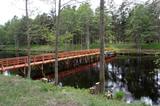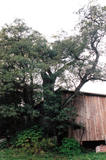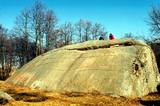| Nr | Name | Beschreibung |
|---|---|---|
|
Unterwegs nach Turaida muss man an der Höhle Gūtmaņa ala (Gutmannshöhle) halten. Diese Höhle ist die breiteste (12 m), die höchste (bis 10 m) und in Bezug auf den Umfang – eine der größten Höhlen in Lettland (eine höhlenartige Nische), die auch ein bedeutender kulturhistorischer und sagenumwobener Ort (die bekannteste ist Sage über die Rose von Turaida) ist, wo man auf den Wänden und auf der Decke auch alte Schriften (die ältesten – aus dem Ende des 17. Jhs.) finden kann. Aus der Höhle fließt eine Quelle, die eine Heilquelle sein soll. An der Stelle, wo das rechte Ufer des Urstromtales von Gauja von Tälern mehrerer kleinen Bäche durchgespaltet wird, befindet sich das Museum-Schutzgebiet von Turaida mit hervorragenden Denkmälern, die im ganzen Baltikum bekannt sind und dessen Geschichte 1000 Jahre alt ist. Die Besichtigung der Denkmäler kann man mit dem Landgut von Turaida (zum ersten Mal im 16. Jh. erwähnt) anfangen, das ein ausgezeichnetes Beispiel der Landgüter der Region Vidzeme ist. Bis heute haben sich hier 21 Gebäude erhalten, die vom 18. Jh. bis zum Anfang des 20. Jhs. gebaut worden sind. Besucher können hier den Pferdestall, den Wagenschuppen, die Sauna, die Schmiede, den Fischkeller, die Kornkammer, das Aufseherhaus, das alte Wohnhaus des Gutsverwalters, das Wohnhaus der Diener, das Darrhaus und andere Gebäude des Landgutes besichtigen. Wenn man Richtung der Burg von Turaida geht, gelangt man an der Grabstätte der Rose von Turaida, mit der die Sage über die Maija von Turaida verbunden ist, die ihr Leben aus Liebe geopfert hat. Neben der Grabstätte wächst eine große Linde (im schlechten Zustand), die auf der Grabstätte von Maija gepflanzt worden sein soll. Wenn man weiter geht, kommt man an der evangelisch-lutherischen Kirche von Turaida, die hier das dritte Gotteshaus und eine der ältesten Kirchen aus Holz (1750) – ein einschiffiger Blockbau aus Holz mit einem Barockturm – in Lettland ist. In der Kirche kann man den Altar und die Kanzel (Mitte des 18. Jhs.), das Altargemälde Golgata (Ende des 17. Jhs. – Anfang des 18. Jhs.) und eine historische Ausstellung besichtigen. Auf dem Berg Dainu kalns (Volksliederberg) breitet sich der Park Tautasdziesmu parks (Volksliederpark) aus, mit dessen Einrichtung 1985 begonnen wurde, als das 150. Jubiläum des Volksliedersammlers Krišjānis Barons gefeiert wurde. Heute befinden sich in dem Park mehr als 26 von dem Bildhauer Indulis Ranka geschaffene Skulpturen aus Stein. Hier finden jährliche Folkloreveranstaltungen statt. Vor dem Bau der gemauerten Burg von Turaida (1214) befand sich hier die aus Holz gebaute Burg der Liven. Die Burg von Turaida gehörte dem Bischof von Riga und bestand bis zum Jahr 1776, als sie niedergebrannt ist. Im Jahr 1953 fingen hier größere Restaurationsarbeiten an, bei denen das Obergeschoß des Hauptturms, die Kornkammer (Ausstellung über die Geschichte des Kreises von Sigulda), der halbrunde Turm und der südliche Teil des Burgkomplexes restauriert wurden. Heute ist in den Räumen der Burg eine Ausstellung eingerichtet, die die historischen Ereignisse der Umgebung schildert. |
||
|
The cafe is situated in the centre of Talsi. |
||
|
This is an artificial body of water that was dug in the 1960s to obtain ice for fish processing plants in Kolka. |
||
|
This is one of two sanatoriums in Jūrmala where mud from the surrounding area is used for medical procedures. The Jūrmala Spa Museum of History was opened here in 2009, and it offers interesting information about the history of the spa and the sanatorium. You will see historical photographs and medical equipment from the 1970s and 1980s. Guides will tell you all kinds of interesting information. |
||
|
Iekārtots bijušā Džūkstes – Lancenieku skolā, kur ikviens var iepazīt mūsu „Pasaku tēva” – Anša Lerha-Puškaita devumu folkloras mantojuma vākšanā.
|
||
|
Beim Besuch der Bierbrauerei kann man den Prozess der Bierherstellung kennenlernen. Verkostung der Biersorten und Malzgetränke, die in der Bierbrauerei hergestellt werden. |
||
|
This is the thickest Black Alder (Alnus glutinosa) in Latvia
|
||
|
Sens pilskalns Abavas kreisā senkrasta nogāzē. Pēc sena nostāsta zviedru karavīri ar savām cepurēm to sabēruši virs sava ģenerāļa kapa. Tagad Zviedru cepures apkārtnē ziemā var braukt pa kalnu slēpošanas trasēm, bet vasarā – ar rodeļiem.
|
||
|
Das bekannteste Museum der Geschichte der Bienenzucht Litauens mit den Bienenhäusern verschidener Arte, der Arbeitsmittel der Bienenzüchter, Holzskulpturen und Hönigankauf. |
||
|
Von Riga führt die Tour durch den historischen Kurort Jurmala bis zum Schokoladenmuseum in Pure, wo Sie die hergestellte Produktion besichtigen und verkosten können. Weiter fahren Sie nach Sabile, wo sich ein kleiner Weinberg befindet, dessen Geschichte schon im 16. Jh. angefangen hat. Sie besuchen einen lokalen Weinhersteller, der seine Gärten zeigt und über Traubenzucht im lettischen Klima erzählt. Danach verkosten Sie Getränke der entsprechenden Saison. Weiter warten auf Sie die malerische Stadt Kuldiga und einige Weinverkostungen. Am nächsten Tag genießen Sie Verkostungen von Bioweinen in Aizpute und Durbe und fahren in die Stadt Liepaja mit ihrem gemütlichen weißen Strand, künstlerischer Atmosphäre und dem bedeutenden Militärerbe in der Vorstadt Kriegshafen. Weiter führt die Tour entlang der Küste bis Pavilosta, wo Sie eine Fahrt mit einem traditionellen Fischerboot unternehmen können, und danach bis Alsunga, wo Sie dem Singen der Suiti-Frauen zuhören und die von ihnen gezeigten lokalen Traditionen erleben können. Diese lebhafte kulturelle Gemeinde gehört zum UNESCO-Welterbe. Danach unternehmen Sie einen Spaziergang entlang der steilen Küste von Jurkalne und genießen die ausgezeichnet gepflegte Hafenstadt Ventspils. Am nächsten Tag besuchen Sie lokale Fischer und Sie können zuschauen, wie Fische geräuchert werden. Sie unternehmen einen Spaziergang um das Kap von Kolka, wo die offene Ostsee mit der Rigaer Bucht zusammentrifft. Auf der Rückfahrt nach Riga besuchen Sie einen Weinhersteller in Talsi und verkosten Weine. |
||
|
Das Ferienhaus befindet sich an einem landschaftlich schönen Ort am Stausee von Rugāji. Der Wirt züchtet und verarbeitet Fische. Hier werden Tische mit lettgallischen Speisen gedeckt. Die Wirte arbeiten mit Bauern und Fischern zusammen. Lettische Küche: Geräucherte Fische (Karpfen, Aalraupen aus dem Peipussee, Schleien, Welse, Brachsen). Dosen mit Brachsen. Fischsuppe aus Karpfen, Schleien und Brachsen. Gerstengrütze mit geräuchertem Fleisch, selbstgebackenes Roggenbrot, vor Ort hergestellte Käse. Das besondere Gericht: Gulaschsuppe aus Schleien. |
||
|
Маршрут походит для любого путешественника, желающего насладиться красотой природы и средой Северного Курземе, где, кроме водных туристов, нет других людей. Ирбе за короткое время стала популярной рекой благодаря красивым береговым ландшафтам. Мест для ночлега здесь нет, поэтому необходимо взять с собой палатку и заночевать на какой-нибудь стоянке для водных туристов. Информация о маршруте от Latvijas Lauku forums |
||
|
Viens no labākajiem veidiem, kā iepazīties ar sidru, ir paviesoties kādā no sidra darītavām, kur klātienē var redzēt, kā sidrs tiek gatavots. Vairākas sidra darītavas piedāvā apmeklējumus, kuros sidrdari parādīs ražošanas procesu, ļaus nodegustēt savu produkciju un pastāstīs par to. Sidrdari pieņem apmeklētājus pēc iepriekšējas pieteikšanās. Rezervējiet savu apmeklējumu laikus, lai mazajās saimniecībās, kur bieži vien strādā tikai pati ģimene vai pāris darbinieku, sidrdari var paspēt apvienot tūristu uzņemšanu ar savu ikdienas darbu. Parasti sidra darītavas uzņem viesus visu cauru gadu, dažos gadalaikos ir iespējams vērot arī ražošanas procesu, tādēļ sidra darītavas apmeklējumam ieplānojiet apmēram 2 stundas. |
||
|
Puises „centrā” uz vienstāvu koka mājiņas jumta izveidota skatu platforma. No tās paveras laba ainava uz ciemu, ostu un piekrastes kadiķu laukiem. |
||
|
This is the only Straw Museum in Latvia, with ~370 sculptures and dolls made of straw and hay. Children in particular will love the chance to learn skills related to straw and hay at the creative straw workshop, where specific methodologies have been developed. Children will be able to take the things that they create along with them. The owners prepare holiday designs and elements, as well as attractive souvenirs. |
||
|
Uzpludinātās Zveņģupītes kreisajā krastā – neliela meža pudura malā (170 m no Rīgas – Daugavpils šosejas (A 6)) atrodas 1991. g. atklātais (autors: Juris Zihmanis) akmens – piemiņas vieta 17. gs. Lielvārdes meitenei Katrīnai, kura kā ragana sadedzināta sārtā. |
||
|
As you travel from Kandava to Sabile, you will find a parking lot on the right side of the road. From there, there are steps to a viewing area on the highest hill in the Abava Ancient River Valley – Greiļi Hill. This offers a wonderful view of the ancient river valley and the local mosaic of meadows and forests. The landscape is enriched by the Imula and Amula valleys that are on the other side of the ancient river valley.
|
||
|
Redāns ir 19. gadsimta beigās celtā Liepājas Jūras cietokšņa daļa, kur notikušas Latvijai nozīmīgas cīņas. Lai gan uzbūvētie nocietinājumi ap Karostu tika atzīti par stratēģisku kļūdu un vairums no tiem saspridzināti, Redāns palicis teju neskarts. Tā ir arī vienīgā nocietinājuma daļa, kur notikusi reāla karadarbība.Par liecina ložu šautie caurumi sienās. 1919. gada 14. novembrī šeit notika brīvības cīņas par neatkarīgu Latviju, aizstāvot Liepāju pret Bermonta karaspēku. 14. novembra rītā, pārejot aizsalušo Tosmares ezeru, bermontiešu kājnieki ieņēma Redānu. Taču dažu stundu laikā liepājnieki veica niknu pretuzbrukumu, un vāciešiem nācās atkāpties. Jūnijā, jūlijā un augustā katru dienu plkst. 11.00–17.00 pie Redāna gaidīs zinošs gids, kas būs gatavs pastāstīt vairāk par Liepājas cietoksni un vēsturiskajiem notikumiem Karostā. Cena – 2 EUR no personas. |
||
|
This is the second largest rock in the Baltic States in terms of size (728 m3). It is the only rock in the Baltic States with this form and size. It is 7 m high, 19 m long, 11 m wide, and 58 m in perimeter. Kabelikivi looks like a cliff that is halfway sunk into the earth. During the Ice Age, the rock “travelled” to this location from southern Finland. It is made of granite, and there are two other very impressive rocks alongside it.
|
||
|
Zwiebeln, Fische, Dörfer, die sich über mehrere Kilometer erstrecken, wo die Gebäude entlang der Hauptstraße gesäumt sind, reich verzierte Kirchen der Altgläubigen, kleine Häfen mit Fischerbooten und Holzhäuser, die jeweils in einer anderen Farbe gestrichen sind! Cafés, Geschäfte und Blick auf den Peipussee, der eher wie ein Meer als wie ein See aussieht. Dies könnte die Beschreibung dieser Tour sein. Diese Tour ist ein sehr interessanter Teil des Waldweges, auf dem Sie die Region des Peipsi-Sees, die Kultur und den Lebensstil der Menschen vor Ort sowie die Natur sehen und genießen können. Die Tour beginnt in Tartu - Estlands zweitgrößter Stadt. Sie fahren mit dem Bus von Tartu nach Varnja, wo Sie mit dem Wandern beginnen. Während der Tour können Sie Kostjas Zwiebelfarm besuchen, wo der Gastgeber die Gäste begrüßt und den Zwiebelanbau präsentiert. Es lohnt sich auch, das Chicorée-Museum in Kalkutta zu besuchen, um die Geschichte des Chicorée-Anbaus in Reihen-Dörfern in der Nähe des Peipus-Sees kennenzulernen. Sie werden auch Alatskivi Castle sehen. In Avinurme empfehlen wir Ihnen, das Holzhandwerkszentrum von Avinurme zu besuchen und sich mit dem lokalen Holzhandwerk vertraut zu machen, Zeit in Holzbearbeitungswerkstätten zu verbringen und eine Auswahl an estnischen traditionellen Lebensmitteln zu probieren oder sogar zuzubereiten. Am Ende der Tour kehren Sie mit dem Bus nach Tartu zurück. |
||

























